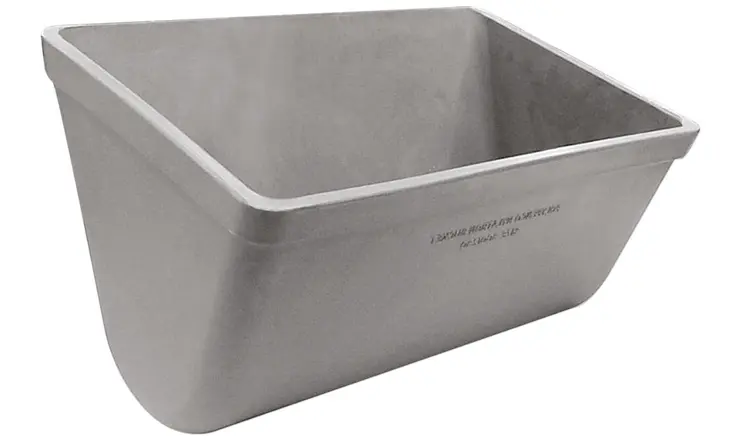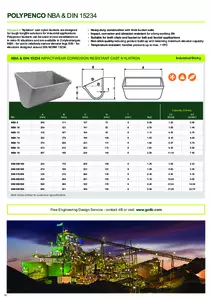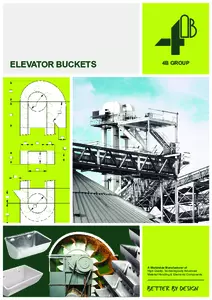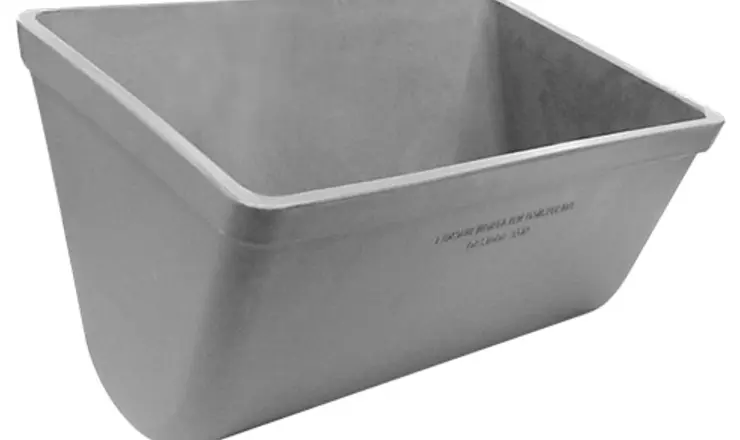Polypenco Nylatron® Buckets
NBA & DIN 15234 Elevator Buckets
NBA8, NBA10, NBA12, NBA14, NBA15, NBA16, NBA18, DIN200/160, DIN250/180, DIN315/200, DIN400/225, DIN500/250, DIN630/280
Polypenco Nylatron cast nylon elevator buckets are designed for tough long life solutions for industrial applications.

Product Features
- Made from Nylatron cast nylon
- Heavy-duty thick walls
- Impact, corrosion and abrasion-resistant
- Anti-stick surface prevents product build-up
- Suitable for both chain and bucket or belt and bucket applications
- Available in two styles:
NBA, for use in relatively narrow elevator legs
DIN, for elevators designed around DIN NORM 15234
Material
Nylon
Use by Industry
Industrial
Use by Product
Sticky Materials,
Light Industrial,
Heavy Industrial
Specifications

| A | B | C | D | T | Weight | Capacity (L) | Capacity (L) | ||
| Polypenco Bucket | (mm) | (mm) | (mm) | (mm) | (mm) | (kg) | Z2 (total) | Z3 (water) | |
| NBA 8 | 206 | 111 | 127 | 73 | 8 | 0.59 | 1.2 | 0.98 | |
| NBA 10 | 254 | 123 | 141 | 82 | 8 | 0.79 | 1.85 | 1.44 | |
| NBA 12 | 318 | 167 | 164 | 93 | 8 | 1.13 | 4.5 | 2.7 | |
| NBA 14 | 362 | 179 | 190 | 109 | 8 | 1.53 | 6.1 | 4 | |
| NBA 15 | 370 | 206 | 223 | 131 | 8 | 1.8 | 8.57 | 5.76 | |
| NBA 16 | 413 | 210 | 203 | 113 | 8 | 1.81 | 9.3 | 5.6 | |
| NBA 18 | 457 | 198 | 229 | 143 | 8 | 2.5 | 11.1 | 7.5 |
| A | B | C | D | T | Weight | Capacity (L) | Capacity (L) | ||
| Polypenco Bucket | (mm) | (mm) | (mm) | (mm) | (mm) | (kg) | Z2 (total) | Z3 (water) | |
| DIN 200/160 | 224 | 178 | 209 | 109 | 8 | 1.25 | 3.65 | 2.23 | |
| DIN 250/180 | 274 | 199 | 233 | 121 | 8 | 1.59 | 5.6 | 3.54 | |
| DIN 315/200 | 339 | 219 | 260 | 135 | 8 | 2.38 | 9.9 | 5.39 | |
| DIN 400/225 | 426 | 244 | 291 | 153 | 8 | 3.18 | 15.2 | 9.05 | |
| DIN 500/250 | 526 | 269 | 328 | 176 | 8 | 4.2 | 23.92 | 14.38 | |
| DIN 630/280 | 656 | 301 | 364 | 193 | 8 | 5.44 | 37.2 | 22.7 |
Bolt holes drilled to customer specification.









